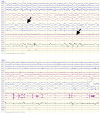Ceftriaxone-Induced Encephalopathy in a Patient With Chronic Kidney Disease
- PMID: 38510903
- PMCID: PMC10954202
- DOI: 10.7759/cureus.54476
Ceftriaxone-Induced Encephalopathy in a Patient With Chronic Kidney Disease
Abstract
Neurotoxicity is an acknowledged side effect of third and fourth-generation cephalosporins, but its occurrence with ceftriaxone is not widely recognized. This article presents a case involving a 56-year-old woman with multiple comorbidities who sought medical attention after experiencing lipothymia. The initial diagnosis suggested a urinary tract infection with acute kidney failure, leading to the initiation of ceftriaxone and hemodialysis. Subsequently, the patient exhibited a progressive deterioration of her neurological state, characterized by agitation and chorea. Metabolic encephalopathy, seizure/nonconvulsive status epilepticus, and acute central nervous system lesions were considered primary differential diagnoses, all of which were subsequently ruled out through thorough investigations. Days later, a remarkable recovery of the patient's neurological state was observed. A retrospective analysis revealed a correlation between the improvement and the fourth day of antimicrobial suspension. Consequently, a presumptive diagnosis of ceftriaxone-induced encephalopathy was made. This unusual case underscores the importance of recognizing the potential for pharmacological encephalopathy, particularly with ceftriaxone, and emphasizes its reversibility upon discontinuation of the implicated drug. Clinicians should remain vigilant to this uncommon adverse effect, promoting timely intervention and improved patient outcomes.
Keywords: ceftriaxone; central nervous system disorders; cephalosporins; chronic kidney disease; drug-induced encephalopathy; neurotoxicity.
Copyright © 2024, Martins et al.
Conflict of interest statement
The authors have declared that no competing interests exist.
Figures

Similar articles
-
Ceftriaxone-Induced Encephalopathy in a Patient With End-Stage Renal Disease on Hemodialysis.Cureus. 2023 Sep 29;15(9):e46226. doi: 10.7759/cureus.46226. eCollection 2023 Sep. Cureus. 2023. PMID: 37905262 Free PMC article.
-
Ceftriaxone-induced acute reversible encephalopathy in a patient treated for a urinary tract infection.Neth J Med. 2009 Feb;67(2):72-5. Neth J Med. 2009. PMID: 19299850
-
Ceftiaxone-induced neurotoxicity: case report, pharmacokinetic considerations, and literature review.J Korean Med Sci. 2012 Sep;27(9):1120-3. doi: 10.3346/jkms.2012.27.9.1120. Epub 2012 Aug 22. J Korean Med Sci. 2012. PMID: 22969263 Free PMC article.
-
Prolonged Cefepime-Induced Neurotoxicity in a Patient with End-Stage Renal Disease.Am J Case Rep. 2022 Jan 24;23:e934083. doi: 10.12659/AJCR.934083. Am J Case Rep. 2022. PMID: 35067669 Free PMC article. Review.
-
Paraneoplastic Encephalopathy in a Patient With Metastatic Lung Cancer: A Case Study.J Adv Pract Oncol. 2018 Mar;9(2):216-221. Epub 2018 Mar 1. J Adv Pract Oncol. 2018. PMID: 30588355 Free PMC article. Review.
References
-
- Ceftriaxone-induced acute reversible encephalopathy in a patient treated for a urinary tract infection. [ Jan; 2024 ];Roncon-Albuquerque R, Pires I, Martins R, Real R, Sousa G, Von Hafe P. https://pubmed.ncbi.nlm.nih.gov/19299850/ Neth J Med. 2009 67:72–75. - PubMed
-
- Pharmacovigilance Risk Assessment Committee. Pharmacovigilance Risk Assessment Committee Recommendations on Signals Adopted at the 26-29 October 2020 PRAC meeting. [ Jan; 2024 ]. 2020. https://www.ema.europa.eu/en/documents/prac-recommendation/prac-recommen... https://www.ema.europa.eu/en/documents/prac-recommendation/prac-recommen...
-
- The WHO AWaRe (Access, Watch, Reserve) antibiotic book and prevention of antimicrobial resistance. Zanichelli V, Sharland M, Cappello B, et al. Bull World Health Organ. 2023;101:290–296.
Publication types
LinkOut - more resources
Full Text Sources
